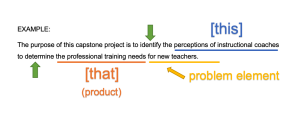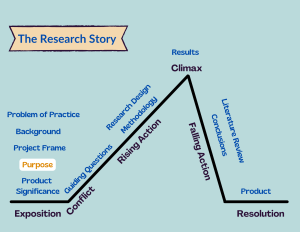Capstone Components
9 The Purpose
The story continues…
As Harry walked back home, he thought, interesting, very interesting. Could it be that the number of mice at my house is simply overwhelming for Pickles? If this is the case, how could I control how many mice are within Pickles’ area of attention? If I only knew that for a fact, I could have Pickles in one room of the house at a time. There, the number of mice coming out could be reduced, and maybe, Pickles would act differently toward them.
Harry had a vision of the Eiffel Tower, a bottle of wine, and the Époisses cheese making him reminisce about his first bite of Époisses. Époisses was his favorite cheese, and the mice keep eating it! This thought made Harry walk faster thinking, yes, I have got to save my cheese!
The next day, Harry got out his journal and wrote down what he wanted to do to reach his goal. He felt good to now have a direction for his research. Harry’s goal was to figure out how to increase Pickles’ motivation to hunt the mice and to build a strategy to save his cheese. Harry shared his goal and ideas with Physicus.
“So, now that I know my goal, what’s next?” Harry asked Physicus.
Harry and Physicus decided to sleep on it.
Interpreting the Story
The goal Harry jotted down gave him direction and helped Harry see what he wanted to do. Wanting to solve the mice problem was not enough. Harry had to decide on a specific hypothesis to frame his research to try to reach the goal of saving his cheese. In research, we cannot accomplish everything at once. Instead, we must focus on using a theory or hypothesis for the project. Harry formulated a clear goal of what he wanted to accomplish (save the cheese) by using his hypothesis (reducing the mice Pickles encountered).
The Purpose
The Purpose expresses the overall intent of the research project. In this heading, the writer explains what central phenomenon will be explored, or analyzed. The Purpose explains what will be accomplished in the project. It provides a brief overview of the expected product of the project, as well as the Purpose Statement.
The Purpose Statement is a declarative sentence, such as, “This capstone project will analyze (or study, or explore) …” The Purpose Statement expresses the point of your research study, the major intent, or the objective resulting in a product. The Purpose Statement is based on a goal to improve, influence, or alleviate the problem. The Purpose Statement is active, not passive.
The basic structure of the Purpose Statement: The purpose of this project is to [action verb] this for/to [action verb] that element of the problem.

The elements of the Purpose Statement can be in any order, however, the main characteristics shown here should be present. The Purpose Statement is active, descriptive, specific, and relates directly to the problem.
The writing explains how the purpose (goal) will address the problem through the project frame. A description of how the purpose will improve, influence, or solve the problem is included. It answers the questions, “What will the project accomplish? How will this project add value to the greater body of knowledge in education? What is the expected product?” The focus of the Purpose is on the future state of the situation after your research is complete.
Telling the Research Story
The Purpose explains the goals of the research project. It explains what to expect at the end of the story, in a general sense. Your writing details how the conflict is expected to be resolved. The Purpose sets the stage for the closing scene. The Purpose appears in Chapter 1 of the capstone project.


